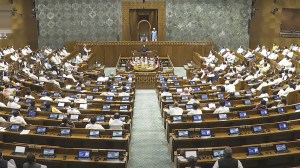Hunting lodge to home of 5 Viceroys: Many faces of DU’s Viceregal Lodge
Speaking to The Indian Express, former DU V-C Professor Dinesh Singh said, “Some of the fiercest battles took place around that building in 1857.
 The structure is a classic colonial white building, with semi-circular arches supported by pillars.
The structure is a classic colonial white building, with semi-circular arches supported by pillars. From a hunting lodge in 1857, a circuit house post-1857 to serving as a residence to five Viceroys, Delhi University’s Viceregal Lodge, which today houses the office of the Vice-Chancellor, pro-chancellor and registrar, has stood witness to several important milestones of the county’s history.
Speaking to The Indian Express, former DU V-C Professor Dinesh Singh said, “Some of the fiercest battles took place around that building in 1857. When the British were ruling Delhi, they used to come to these parts to hunt and when they were evicted during the 1857 War of Independence from Delhi, they took refuge on the Ridge, including at the Viceregal Lodge, which was back then a hunting lodge… The revolutionaries who had come to battle had surrounded the entire area.”
“In fact, just before I became the V-C, the flagstaff right up the hill used to bear the bullet and cannon marks of 1857,” Singh said.
The structure is a classic colonial white building, with semi-circular arches supported by pillars. It has a single spacious, airy corridor running through the entire building. A central porch leads right up to the V-C’s office and on the other side are gardens, where the university’s annual flower show is held. It was known as DU’s Mughal Garden and was recently renamed by the varsity as Gautam Buddha Centenary Garden.
“From 1900, more houses were built in the Civil Lines, inhabited by railway and factory personnel among others. In 1911, when the decision to transfer the country’s capital from Calcutta to Delhi was taken, the Viceregal Lodge and Secretariat were constructed,” said an excerpt from a report by the Delhi Metropolitan Council, 1966-1989.
The Viceregal Lodge was built on the other side of the ridge, and housed Lord Hardinge. His successors Lord Chelmsford, Lord Reading and Lord Irwin lived and worked from this building.
“During the Durbar of 1903, the coronation to celebrate King Edward VII, camps were set up in what we today call DU’s North Campus. The Viceregal Lodge was a circuit house which was built for Viceroy Curzon and Lady Curzon so they could stay there, and once the capital shifted from Calcutta to Delhi in 1912, it housed the viceroys. Then it became vacant for a little while after which DU moved in there,” said writer and historian Swapna Liddle.
“Civil Lines remained a temporary capital when in December 1929 Lord and Lady Irwin occupied the Viceregal Lodge in the permanent capital New Delhi,” said a report by the Delhi Metropolitan Council, 1966-1989.
Lord Irwin was the last viceroy to have lived there, moving to the Rashtrapati Bhavan when it was built in 1929.
“Mahatma Gandhi traversed these corridors in planning for a free nation, especially attending lengthy meetings before signing the pact with Lord Irwin in 1931 and the hidden chamber of Shaheed Bhagat Singh’s confinement in the basement of this building can be visited for the first time,” said an excerpt from the DU centenary archive.
Singh, who spent his tenure as V-C between 2010-2015 in the building, had located the dungeon and converted it into a museum to mark the memory of Bhagat Singh. “There is a room in the building which is currently the office of the registrar, where when Lord Mountbatten became the Viceroy, he was also the chancellor of the university, that’s when he mentioned the story about him proposing to Edwina Ashley in that same room, when she came to live in the lodge along with her uncle Lord Redding,” said Singh.
The Viceregal Lodge Estate was given over to the University of Delhi in 1933 after the varsity’s inception on May 1, 1922.
By June 5, 1933, the university was given a temporary site near the Viceregal Lodge Estate building where it moved its office, library, lecture rooms, law hall and science laboratory but no permanent arrangement was made.
As per the book, ‘A History of Educational Institutions in Delhi 1911 to 1961’, by Ajay Kumar Sharma, the main building with European servants’ wing was allotted for the university office, library, lecture rooms, convocation hall, meeting and office rooms. Princes’ Pavilion and kitchens were allotted for Physics and Chemistry laboratories respectively. ‘E’ type quarters were for the residence of two members of office staff, godowns, outhouse and tennis court for the residence of menial staff and recreational purposes, said the book.
In 1948, a special convocation took place here, where Jawaharlal Nehru and Lord Mountbatten were conferred honorary doctorates, said Singh.












